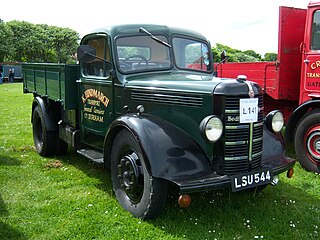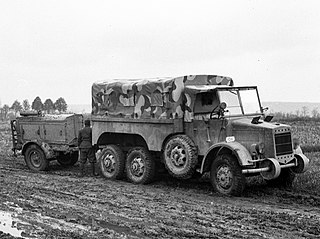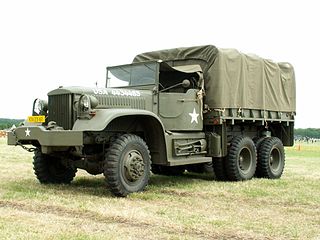
Commer was a British manufacturer of commercial and military vehicles from 1905 until 1979. Commer vehicles included car-derived vans, light vans, medium to heavy commercial trucks, and buses. The company also designed and built some of its own diesel engines for its heavy commercial vehicles.

Associated Equipment Company (AEC) was a British vehicle manufacturer that built buses, motorcoaches and trucks from 1912 until 1979. The name Associated Equipment Company was hardly ever used; instead, it traded under the AEC and ACLO brands. During World War One, AEC was the most prolific British lorry manufacturer, after building London's buses before the war.

The Austin Champ was a military and civilian jeep-like vehicle made by the Austin Motor Company in the 1950s. The army version was officially known as "Truck, 1/4 ton, CT, 4×4, Cargo & FFW, Austin Mk.1" however the civilian name "Champ" was universally, if unofficially, applied to it. The majority of Champs produced went to the British Army.
Scammell Lorries Limited was a British manufacturer of trucks, particularly specialist and military off-highway vehicles, between 1921 and 1988. From 1955 Scammell was part of Leyland Motors.

The AEC Matador was a heavy 4×4 truck and medium artillery tractor built by the Associated Equipment Company for British and Commonwealth forces during World War II. AEC had already built a 4×2 lorry, also known as the Matador.
Bedford Vehicles, usually shortened to just Bedford, was a brand of vehicle manufactured by Vauxhall Motors, then a subsidiary of multinational corporation General Motors. Established in April 1931, Bedford Vehicles was set up to build commercial vehicles. The company was a leading international lorry brand, with substantial export sales of light, medium, and heavy lorries throughout the world.

The Bedford M series is a line of commercial vehicle chassis, the first variants of which were made in 1939 by Bedford. It is a normal control 4-wheel chassis designed to carry loads of 2-3 tons. There were two wheelbase lengths offered – 10' 0" or 11' 11" – and each was fitted with the standard 6-cylinder 76 bhp petrol engine. A 4-speed gearbox with single dry plate clutch delivered power to a floating rear axle with spiral bevel final drive. Brakes were Lockheed hydraulic type and vacuum assisted operating on all four wheels.

Portée describes the practice of carrying an artillery piece on a truck which can be fired from the vehicle or quickly dismounted and fired from the ground. The term is most often used to describe anti-tank equipments used by the British, Commonwealth and imperial forces in the Western Desert Campaign of the Second World War. Modern terms for mounting weapons on vehicles are technical or gun truck.

The Diamond T Company was an American automobile and truck manufacturer. They produced commercial and military trucks.

The Scammell Pioneer was a British 6×4 tractor unit used in World War II as an artillery tractor, recovery vehicle and tank transporter.

FAP 2026 is a general purpose off-road lorry made by Serbian vehicle manufacturer Fabrika automobila Priboj (FAP). The six-wheel drive lorry is designed for transport of personnel, weapons and material up to 6 tons of total weight, as for traction of weapons and trailer up to 7.2 tons of weight for the needs of the Yugoslav People's Army.

The Bedford RL was the British military's main medium lorry, built by Bedford from the mid-1950s until the late 1960s. The lorry was based on the civilian Bedford S type, first introduced in 1950. They superseded the Bedford QL, and were in turn superseded by the Bedford MK/MJ.

Canadian Military Pattern (CMP) trucks were mutually coherent ranges of military trucks, made in large numbers, in several classes and numerous versions, by Canada's branches of the U.S. 'Big Three' auto-makers during World War II, compliant to British Army specifications, primarily intended for use in the armies of the British Commonwealth allies, but also serving in other units of the British Empire.

The Bison was an improvised fighting vehicle frequently characterised as a mobile pillbox. Bisons were produced in Britain during the invasion crisis of 1940-1941. Based on a number of different lorry chassis, it featured a fighting compartment protected by a layer of concrete. Bisons were used by the Royal Air Force (RAF) to protect aerodromes and by the Home Guard. They acquired the generic name "Bison" from their main manufacturer.

The Bedford OY is an army lorry (truck) built by Bedford for the British Armed Forces and introduced in 1939. It was based on Bedford's O-series commercial vehicles with a modified front end and single rear tyres. It was designed for a 3-ton payload. The OYD was a general service vehicle, while the OYC was a tanker version for carrying water or petrol. These vehicles were widely used during, and after, World War II but were later superseded by the Bedford RL.

Rába 38M Botond was a Hungarian all-terrain truck. Designed by Győr-based Rába Magyar Vagon- és Gépgyár works, it was extensively used by the Royal Hungarian Army during World War II. The truck was based on a successful Raba AFi truck chassis, but was built in a relatively rare configuration of 6x4. This 1.5 ton lorry was used to ferry both cargo and personnel. There is only one surviving truck, currently in the Transport Museum of Budapest.

The Diamond T 4-ton 6×6 truck was a heavy tactical truck built for the United States Army during World War II. Its G-number was G-509. Cargo models were designed to transport a 4-ton (3,600 kg) load over all terrain in all weather. There were also wrecker, dump, and other models. They were replaced by the M39 series 5-ton 6×6 trucks in the 1950s.

The Bedford MW was a general service truck used by the British Armed Forces during the Second World War.

ZIL-133 is a Soviet/Russian 3 axle straight truck produced by ZIL in Moscow from 1975 to 2000. The first prototypes were developed in the early 1970s years in the Soviet Union. It was intended as a 3 axle version of the ZIL-130 with a higher payload.

The Morris Commercial CS8, also known as the "Morris 15 cwt" was a British light military truck of the Second World War.





















